Restaurant Server Work Practices
VerifiedAdded on 2020/05/28
|10
|2378
|343
AI Summary
This assignment focuses on the tasks and procedures involved in closing down a restaurant after service. It covers operational issues resolution, end-of-shift duties like cleaning and equipment shutdown, storage protocols for various materials, information transfer between shifts, and feedback mechanisms within the team.
Contribute Materials
Your contribution can guide someone’s learning journey. Share your
documents today.
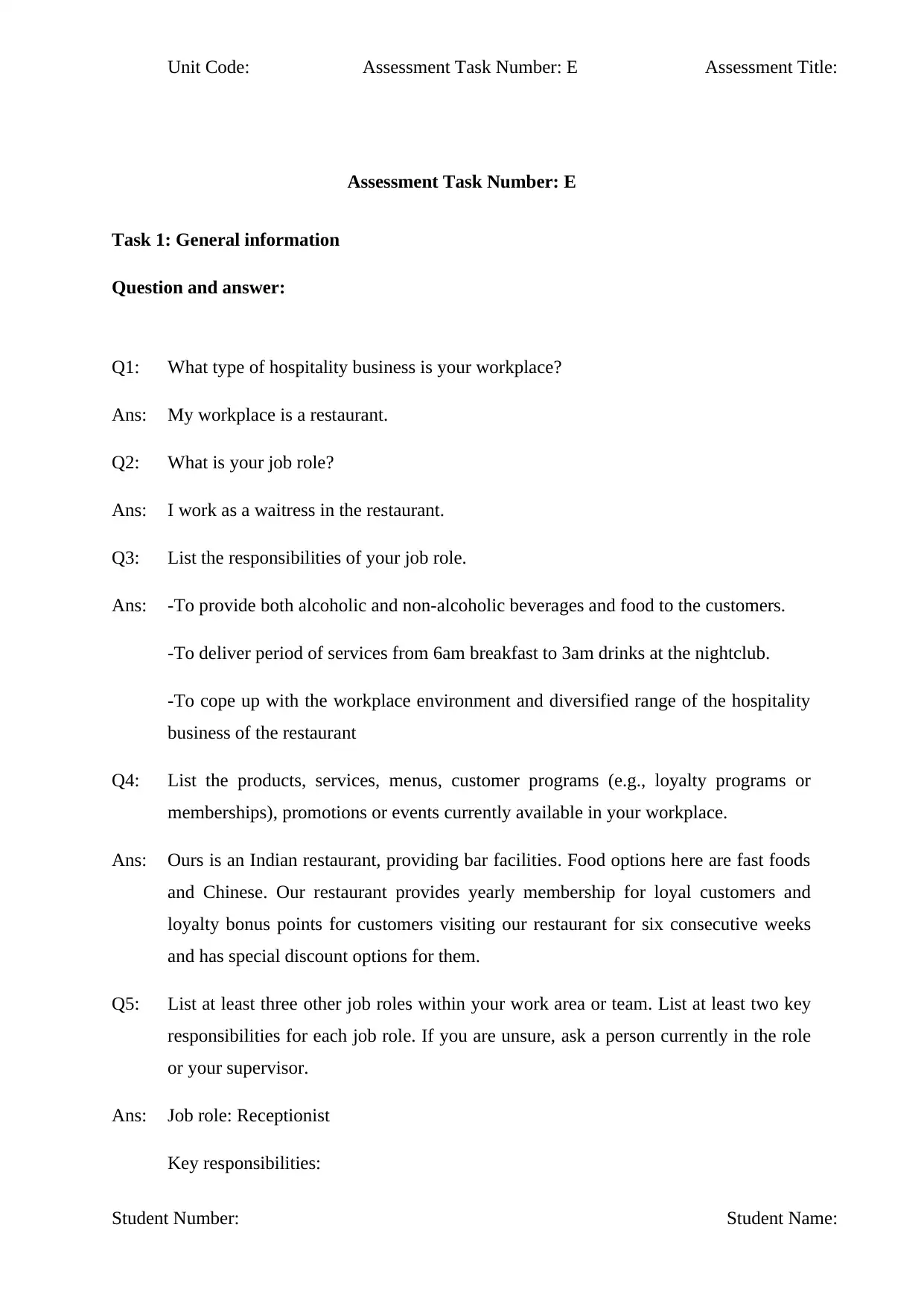
Unit Code: Assessment Task Number: E Assessment Title:
Assessment Task Number: E
Task 1: General information
Question and answer:
Q1: What type of hospitality business is your workplace?
Ans: My workplace is a restaurant.
Q2: What is your job role?
Ans: I work as a waitress in the restaurant.
Q3: List the responsibilities of your job role.
Ans: -To provide both alcoholic and non-alcoholic beverages and food to the customers.
-To deliver period of services from 6am breakfast to 3am drinks at the nightclub.
-To cope up with the workplace environment and diversified range of the hospitality
business of the restaurant
Q4: List the products, services, menus, customer programs (e.g., loyalty programs or
memberships), promotions or events currently available in your workplace.
Ans: Ours is an Indian restaurant, providing bar facilities. Food options here are fast foods
and Chinese. Our restaurant provides yearly membership for loyal customers and
loyalty bonus points for customers visiting our restaurant for six consecutive weeks
and has special discount options for them.
Q5: List at least three other job roles within your work area or team. List at least two key
responsibilities for each job role. If you are unsure, ask a person currently in the role
or your supervisor.
Ans: Job role: Receptionist
Key responsibilities:
Student Number: Student Name:
Assessment Task Number: E
Task 1: General information
Question and answer:
Q1: What type of hospitality business is your workplace?
Ans: My workplace is a restaurant.
Q2: What is your job role?
Ans: I work as a waitress in the restaurant.
Q3: List the responsibilities of your job role.
Ans: -To provide both alcoholic and non-alcoholic beverages and food to the customers.
-To deliver period of services from 6am breakfast to 3am drinks at the nightclub.
-To cope up with the workplace environment and diversified range of the hospitality
business of the restaurant
Q4: List the products, services, menus, customer programs (e.g., loyalty programs or
memberships), promotions or events currently available in your workplace.
Ans: Ours is an Indian restaurant, providing bar facilities. Food options here are fast foods
and Chinese. Our restaurant provides yearly membership for loyal customers and
loyalty bonus points for customers visiting our restaurant for six consecutive weeks
and has special discount options for them.
Q5: List at least three other job roles within your work area or team. List at least two key
responsibilities for each job role. If you are unsure, ask a person currently in the role
or your supervisor.
Ans: Job role: Receptionist
Key responsibilities:
Student Number: Student Name:
Secure Best Marks with AI Grader
Need help grading? Try our AI Grader for instant feedback on your assignments.
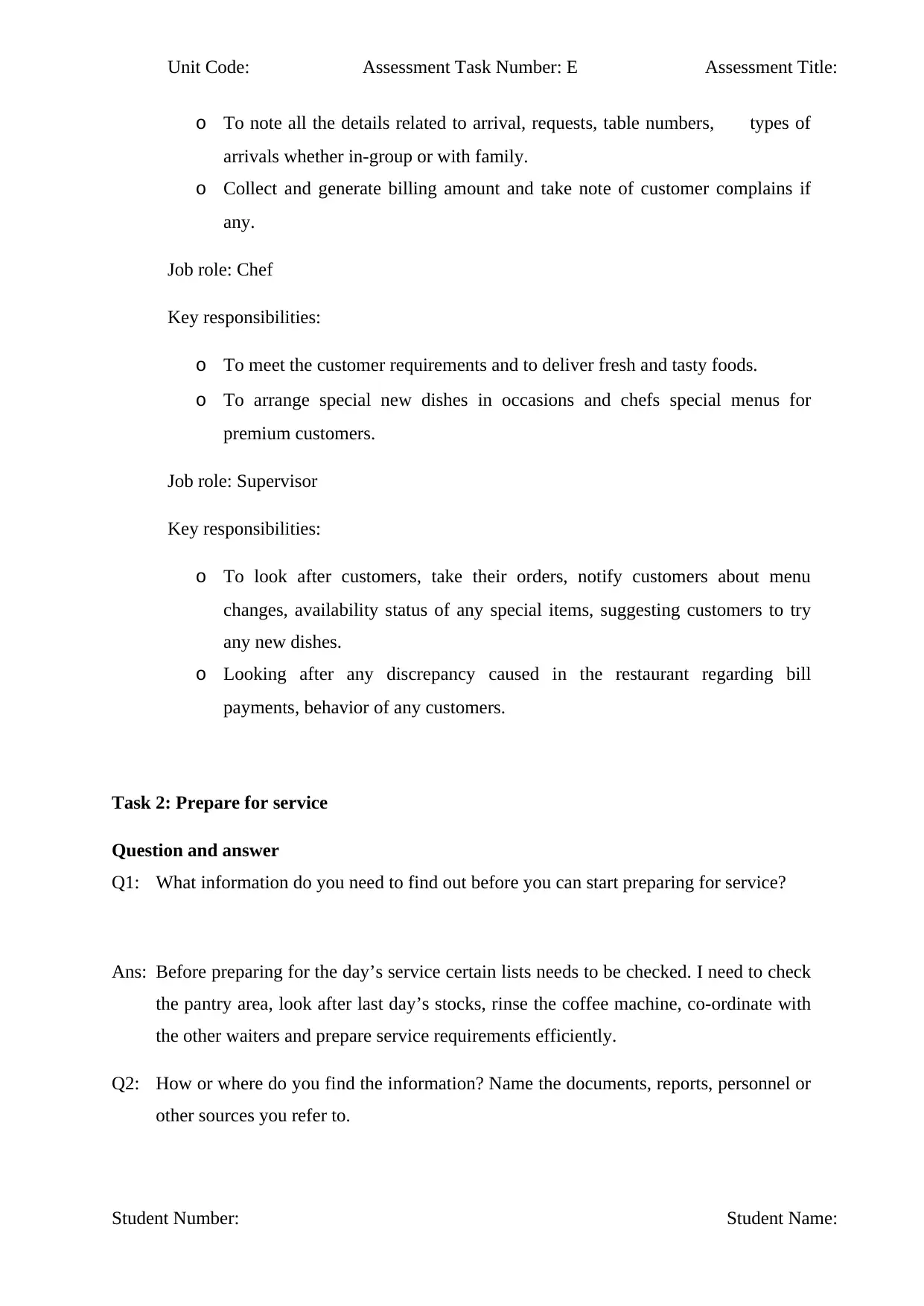
Unit Code: Assessment Task Number: E Assessment Title:
o To note all the details related to arrival, requests, table numbers, types of
arrivals whether in-group or with family.
o Collect and generate billing amount and take note of customer complains if
any.
Job role: Chef
Key responsibilities:
o To meet the customer requirements and to deliver fresh and tasty foods.
o To arrange special new dishes in occasions and chefs special menus for
premium customers.
Job role: Supervisor
Key responsibilities:
o To look after customers, take their orders, notify customers about menu
changes, availability status of any special items, suggesting customers to try
any new dishes.
o Looking after any discrepancy caused in the restaurant regarding bill
payments, behavior of any customers.
Task 2: Prepare for service
Question and answer
Q1: What information do you need to find out before you can start preparing for service?
Ans: Before preparing for the day’s service certain lists needs to be checked. I need to check
the pantry area, look after last day’s stocks, rinse the coffee machine, co-ordinate with
the other waiters and prepare service requirements efficiently.
Q2: How or where do you find the information? Name the documents, reports, personnel or
other sources you refer to.
Student Number: Student Name:
o To note all the details related to arrival, requests, table numbers, types of
arrivals whether in-group or with family.
o Collect and generate billing amount and take note of customer complains if
any.
Job role: Chef
Key responsibilities:
o To meet the customer requirements and to deliver fresh and tasty foods.
o To arrange special new dishes in occasions and chefs special menus for
premium customers.
Job role: Supervisor
Key responsibilities:
o To look after customers, take their orders, notify customers about menu
changes, availability status of any special items, suggesting customers to try
any new dishes.
o Looking after any discrepancy caused in the restaurant regarding bill
payments, behavior of any customers.
Task 2: Prepare for service
Question and answer
Q1: What information do you need to find out before you can start preparing for service?
Ans: Before preparing for the day’s service certain lists needs to be checked. I need to check
the pantry area, look after last day’s stocks, rinse the coffee machine, co-ordinate with
the other waiters and prepare service requirements efficiently.
Q2: How or where do you find the information? Name the documents, reports, personnel or
other sources you refer to.
Student Number: Student Name:
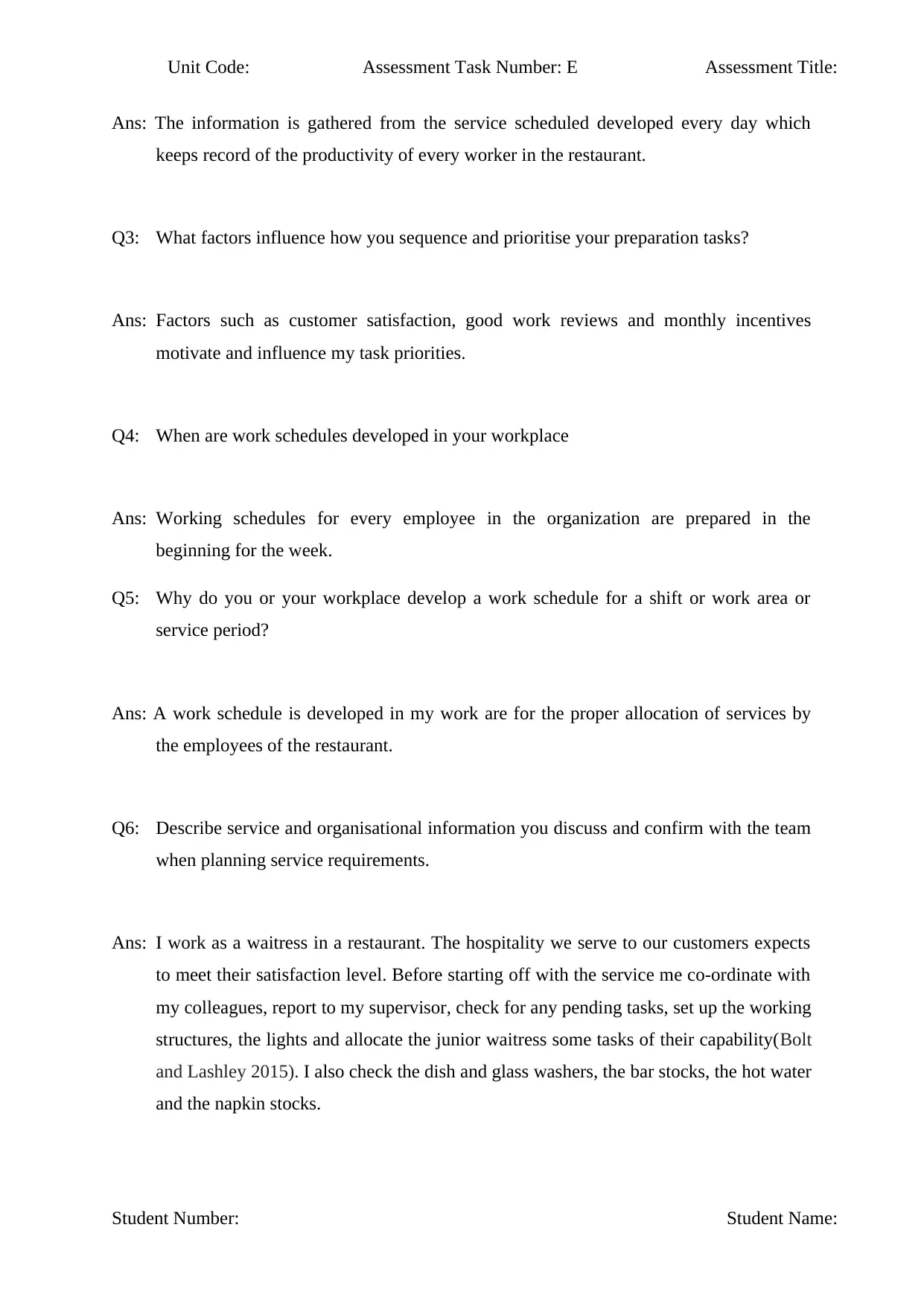
Unit Code: Assessment Task Number: E Assessment Title:
Ans: The information is gathered from the service scheduled developed every day which
keeps record of the productivity of every worker in the restaurant.
Q3: What factors influence how you sequence and prioritise your preparation tasks?
Ans: Factors such as customer satisfaction, good work reviews and monthly incentives
motivate and influence my task priorities.
Q4: When are work schedules developed in your workplace
Ans: Working schedules for every employee in the organization are prepared in the
beginning for the week.
Q5: Why do you or your workplace develop a work schedule for a shift or work area or
service period?
Ans: A work schedule is developed in my work are for the proper allocation of services by
the employees of the restaurant.
Q6: Describe service and organisational information you discuss and confirm with the team
when planning service requirements.
Ans: I work as a waitress in a restaurant. The hospitality we serve to our customers expects
to meet their satisfaction level. Before starting off with the service me co-ordinate with
my colleagues, report to my supervisor, check for any pending tasks, set up the working
structures, the lights and allocate the junior waitress some tasks of their capability(Bolt
and Lashley 2015). I also check the dish and glass washers, the bar stocks, the hot water
and the napkin stocks.
Student Number: Student Name:
Ans: The information is gathered from the service scheduled developed every day which
keeps record of the productivity of every worker in the restaurant.
Q3: What factors influence how you sequence and prioritise your preparation tasks?
Ans: Factors such as customer satisfaction, good work reviews and monthly incentives
motivate and influence my task priorities.
Q4: When are work schedules developed in your workplace
Ans: Working schedules for every employee in the organization are prepared in the
beginning for the week.
Q5: Why do you or your workplace develop a work schedule for a shift or work area or
service period?
Ans: A work schedule is developed in my work are for the proper allocation of services by
the employees of the restaurant.
Q6: Describe service and organisational information you discuss and confirm with the team
when planning service requirements.
Ans: I work as a waitress in a restaurant. The hospitality we serve to our customers expects
to meet their satisfaction level. Before starting off with the service me co-ordinate with
my colleagues, report to my supervisor, check for any pending tasks, set up the working
structures, the lights and allocate the junior waitress some tasks of their capability(Bolt
and Lashley 2015). I also check the dish and glass washers, the bar stocks, the hot water
and the napkin stocks.
Student Number: Student Name:
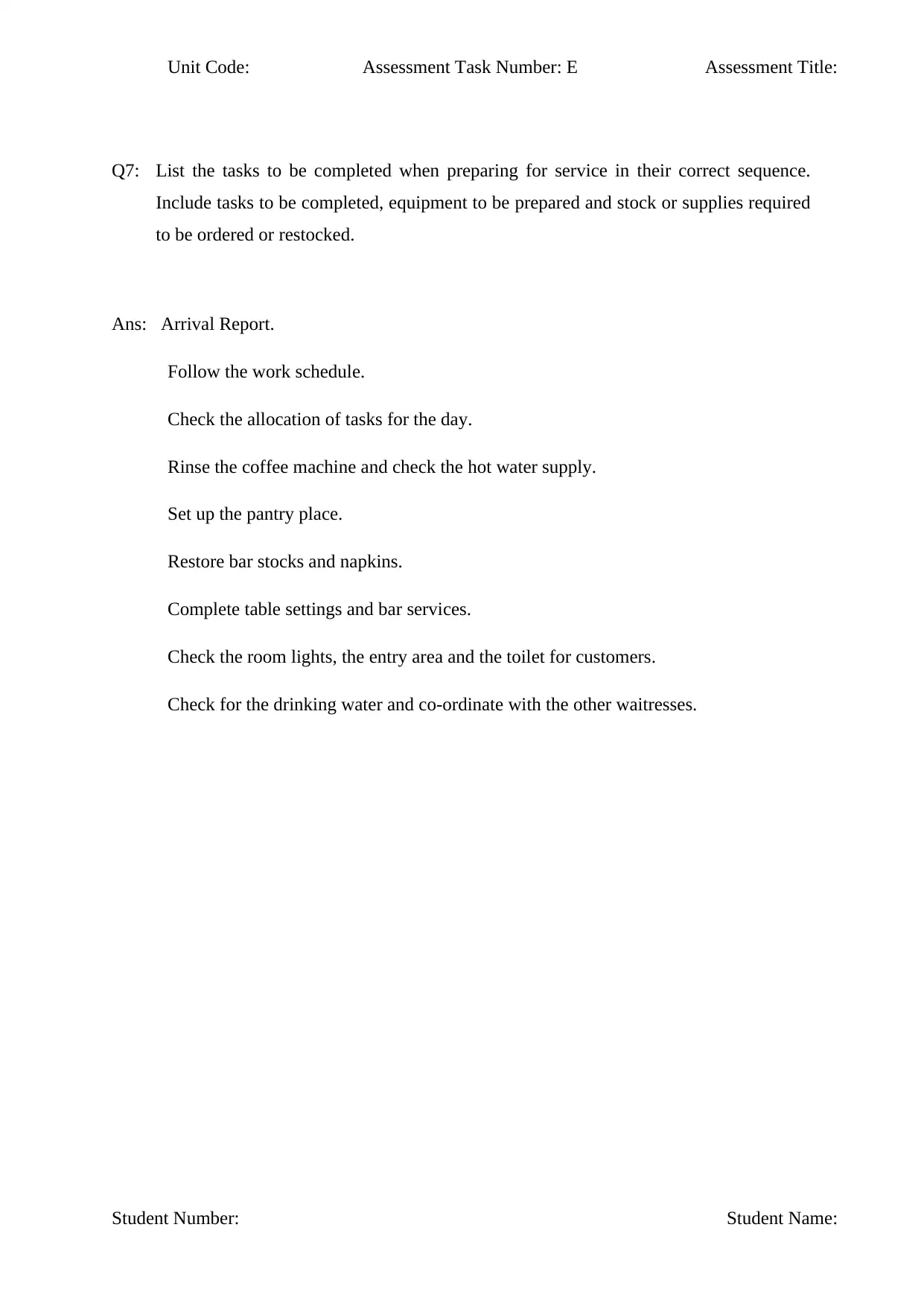
Unit Code: Assessment Task Number: E Assessment Title:
Q7: List the tasks to be completed when preparing for service in their correct sequence.
Include tasks to be completed, equipment to be prepared and stock or supplies required
to be ordered or restocked.
Ans: Arrival Report.
Follow the work schedule.
Check the allocation of tasks for the day.
Rinse the coffee machine and check the hot water supply.
Set up the pantry place.
Restore bar stocks and napkins.
Complete table settings and bar services.
Check the room lights, the entry area and the toilet for customers.
Check for the drinking water and co-ordinate with the other waitresses.
Student Number: Student Name:
Q7: List the tasks to be completed when preparing for service in their correct sequence.
Include tasks to be completed, equipment to be prepared and stock or supplies required
to be ordered or restocked.
Ans: Arrival Report.
Follow the work schedule.
Check the allocation of tasks for the day.
Rinse the coffee machine and check the hot water supply.
Set up the pantry place.
Restore bar stocks and napkins.
Complete table settings and bar services.
Check the room lights, the entry area and the toilet for customers.
Check for the drinking water and co-ordinate with the other waitresses.
Student Number: Student Name:
Secure Best Marks with AI Grader
Need help grading? Try our AI Grader for instant feedback on your assignments.
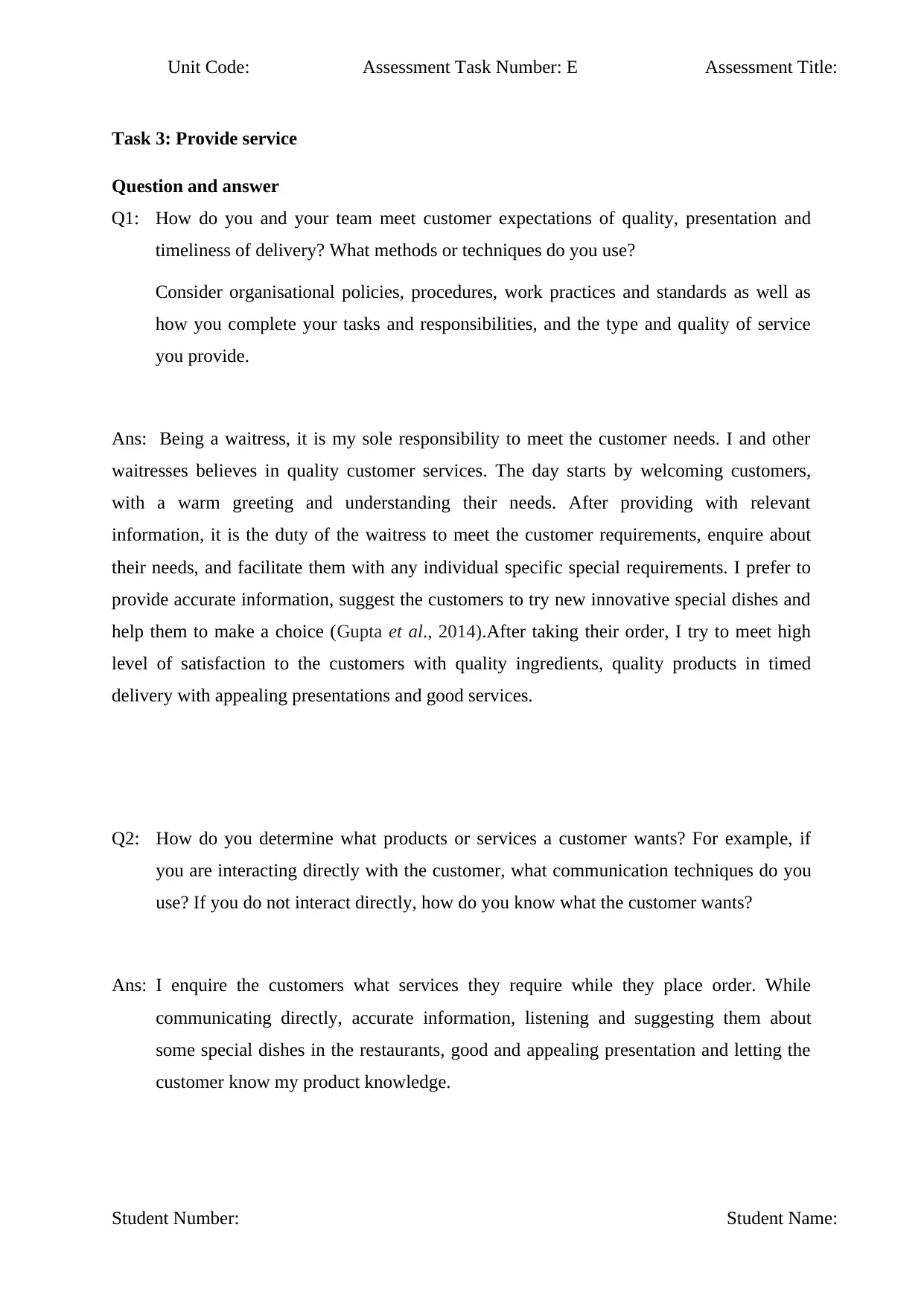
Unit Code: Assessment Task Number: E Assessment Title:
Task 3: Provide service
Question and answer
Q1: How do you and your team meet customer expectations of quality, presentation and
timeliness of delivery? What methods or techniques do you use?
Consider organisational policies, procedures, work practices and standards as well as
how you complete your tasks and responsibilities, and the type and quality of service
you provide.
Ans: Being a waitress, it is my sole responsibility to meet the customer needs. I and other
waitresses believes in quality customer services. The day starts by welcoming customers,
with a warm greeting and understanding their needs. After providing with relevant
information, it is the duty of the waitress to meet the customer requirements, enquire about
their needs, and facilitate them with any individual specific special requirements. I prefer to
provide accurate information, suggest the customers to try new innovative special dishes and
help them to make a choice (Gupta et al., 2014).After taking their order, I try to meet high
level of satisfaction to the customers with quality ingredients, quality products in timed
delivery with appealing presentations and good services.
Q2: How do you determine what products or services a customer wants? For example, if
you are interacting directly with the customer, what communication techniques do you
use? If you do not interact directly, how do you know what the customer wants?
Ans: I enquire the customers what services they require while they place order. While
communicating directly, accurate information, listening and suggesting them about
some special dishes in the restaurants, good and appealing presentation and letting the
customer know my product knowledge.
Student Number: Student Name:
Task 3: Provide service
Question and answer
Q1: How do you and your team meet customer expectations of quality, presentation and
timeliness of delivery? What methods or techniques do you use?
Consider organisational policies, procedures, work practices and standards as well as
how you complete your tasks and responsibilities, and the type and quality of service
you provide.
Ans: Being a waitress, it is my sole responsibility to meet the customer needs. I and other
waitresses believes in quality customer services. The day starts by welcoming customers,
with a warm greeting and understanding their needs. After providing with relevant
information, it is the duty of the waitress to meet the customer requirements, enquire about
their needs, and facilitate them with any individual specific special requirements. I prefer to
provide accurate information, suggest the customers to try new innovative special dishes and
help them to make a choice (Gupta et al., 2014).After taking their order, I try to meet high
level of satisfaction to the customers with quality ingredients, quality products in timed
delivery with appealing presentations and good services.
Q2: How do you determine what products or services a customer wants? For example, if
you are interacting directly with the customer, what communication techniques do you
use? If you do not interact directly, how do you know what the customer wants?
Ans: I enquire the customers what services they require while they place order. While
communicating directly, accurate information, listening and suggesting them about
some special dishes in the restaurants, good and appealing presentation and letting the
customer know my product knowledge.
Student Number: Student Name:
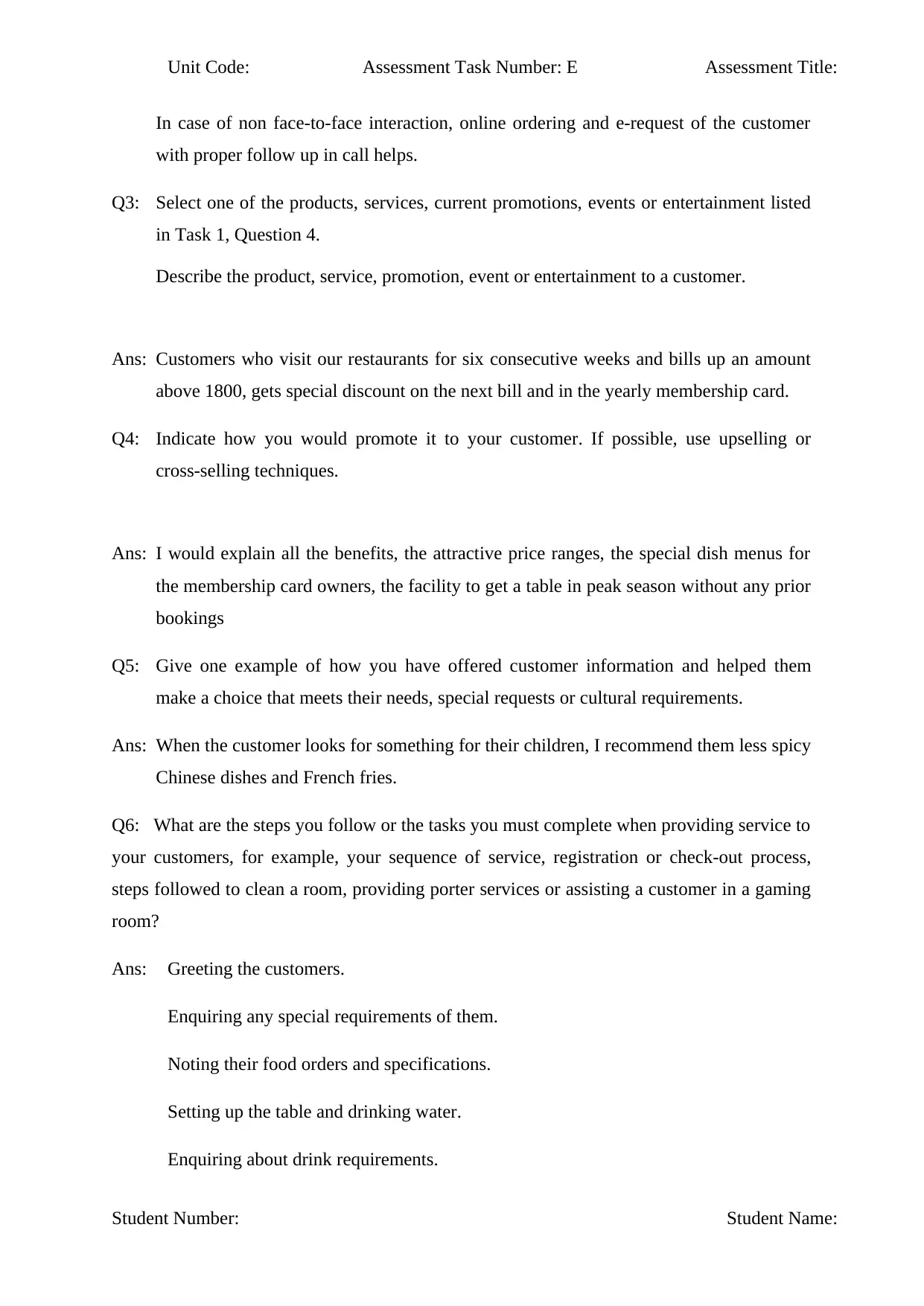
Unit Code: Assessment Task Number: E Assessment Title:
In case of non face-to-face interaction, online ordering and e-request of the customer
with proper follow up in call helps.
Q3: Select one of the products, services, current promotions, events or entertainment listed
in Task 1, Question 4.
Describe the product, service, promotion, event or entertainment to a customer.
Ans: Customers who visit our restaurants for six consecutive weeks and bills up an amount
above 1800, gets special discount on the next bill and in the yearly membership card.
Q4: Indicate how you would promote it to your customer. If possible, use upselling or
cross-selling techniques.
Ans: I would explain all the benefits, the attractive price ranges, the special dish menus for
the membership card owners, the facility to get a table in peak season without any prior
bookings
Q5: Give one example of how you have offered customer information and helped them
make a choice that meets their needs, special requests or cultural requirements.
Ans: When the customer looks for something for their children, I recommend them less spicy
Chinese dishes and French fries.
Q6: What are the steps you follow or the tasks you must complete when providing service to
your customers, for example, your sequence of service, registration or check-out process,
steps followed to clean a room, providing porter services or assisting a customer in a gaming
room?
Ans: Greeting the customers.
Enquiring any special requirements of them.
Noting their food orders and specifications.
Setting up the table and drinking water.
Enquiring about drink requirements.
Student Number: Student Name:
In case of non face-to-face interaction, online ordering and e-request of the customer
with proper follow up in call helps.
Q3: Select one of the products, services, current promotions, events or entertainment listed
in Task 1, Question 4.
Describe the product, service, promotion, event or entertainment to a customer.
Ans: Customers who visit our restaurants for six consecutive weeks and bills up an amount
above 1800, gets special discount on the next bill and in the yearly membership card.
Q4: Indicate how you would promote it to your customer. If possible, use upselling or
cross-selling techniques.
Ans: I would explain all the benefits, the attractive price ranges, the special dish menus for
the membership card owners, the facility to get a table in peak season without any prior
bookings
Q5: Give one example of how you have offered customer information and helped them
make a choice that meets their needs, special requests or cultural requirements.
Ans: When the customer looks for something for their children, I recommend them less spicy
Chinese dishes and French fries.
Q6: What are the steps you follow or the tasks you must complete when providing service to
your customers, for example, your sequence of service, registration or check-out process,
steps followed to clean a room, providing porter services or assisting a customer in a gaming
room?
Ans: Greeting the customers.
Enquiring any special requirements of them.
Noting their food orders and specifications.
Setting up the table and drinking water.
Enquiring about drink requirements.
Student Number: Student Name:
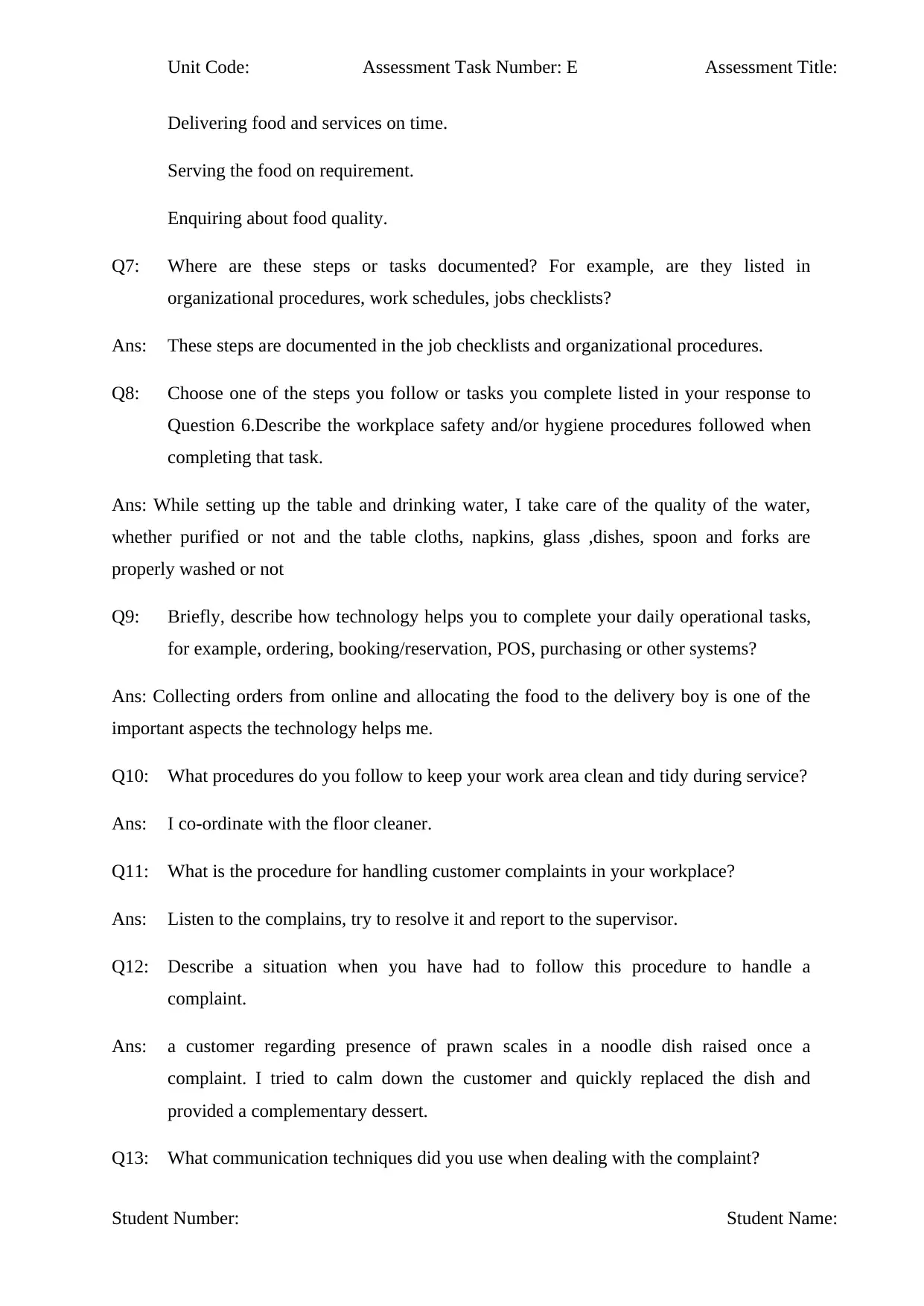
Unit Code: Assessment Task Number: E Assessment Title:
Delivering food and services on time.
Serving the food on requirement.
Enquiring about food quality.
Q7: Where are these steps or tasks documented? For example, are they listed in
organizational procedures, work schedules, jobs checklists?
Ans: These steps are documented in the job checklists and organizational procedures.
Q8: Choose one of the steps you follow or tasks you complete listed in your response to
Question 6.Describe the workplace safety and/or hygiene procedures followed when
completing that task.
Ans: While setting up the table and drinking water, I take care of the quality of the water,
whether purified or not and the table cloths, napkins, glass ,dishes, spoon and forks are
properly washed or not
Q9: Briefly, describe how technology helps you to complete your daily operational tasks,
for example, ordering, booking/reservation, POS, purchasing or other systems?
Ans: Collecting orders from online and allocating the food to the delivery boy is one of the
important aspects the technology helps me.
Q10: What procedures do you follow to keep your work area clean and tidy during service?
Ans: I co-ordinate with the floor cleaner.
Q11: What is the procedure for handling customer complaints in your workplace?
Ans: Listen to the complains, try to resolve it and report to the supervisor.
Q12: Describe a situation when you have had to follow this procedure to handle a
complaint.
Ans: a customer regarding presence of prawn scales in a noodle dish raised once a
complaint. I tried to calm down the customer and quickly replaced the dish and
provided a complementary dessert.
Q13: What communication techniques did you use when dealing with the complaint?
Student Number: Student Name:
Delivering food and services on time.
Serving the food on requirement.
Enquiring about food quality.
Q7: Where are these steps or tasks documented? For example, are they listed in
organizational procedures, work schedules, jobs checklists?
Ans: These steps are documented in the job checklists and organizational procedures.
Q8: Choose one of the steps you follow or tasks you complete listed in your response to
Question 6.Describe the workplace safety and/or hygiene procedures followed when
completing that task.
Ans: While setting up the table and drinking water, I take care of the quality of the water,
whether purified or not and the table cloths, napkins, glass ,dishes, spoon and forks are
properly washed or not
Q9: Briefly, describe how technology helps you to complete your daily operational tasks,
for example, ordering, booking/reservation, POS, purchasing or other systems?
Ans: Collecting orders from online and allocating the food to the delivery boy is one of the
important aspects the technology helps me.
Q10: What procedures do you follow to keep your work area clean and tidy during service?
Ans: I co-ordinate with the floor cleaner.
Q11: What is the procedure for handling customer complaints in your workplace?
Ans: Listen to the complains, try to resolve it and report to the supervisor.
Q12: Describe a situation when you have had to follow this procedure to handle a
complaint.
Ans: a customer regarding presence of prawn scales in a noodle dish raised once a
complaint. I tried to calm down the customer and quickly replaced the dish and
provided a complementary dessert.
Q13: What communication techniques did you use when dealing with the complaint?
Student Number: Student Name:
Paraphrase This Document
Need a fresh take? Get an instant paraphrase of this document with our AI Paraphraser
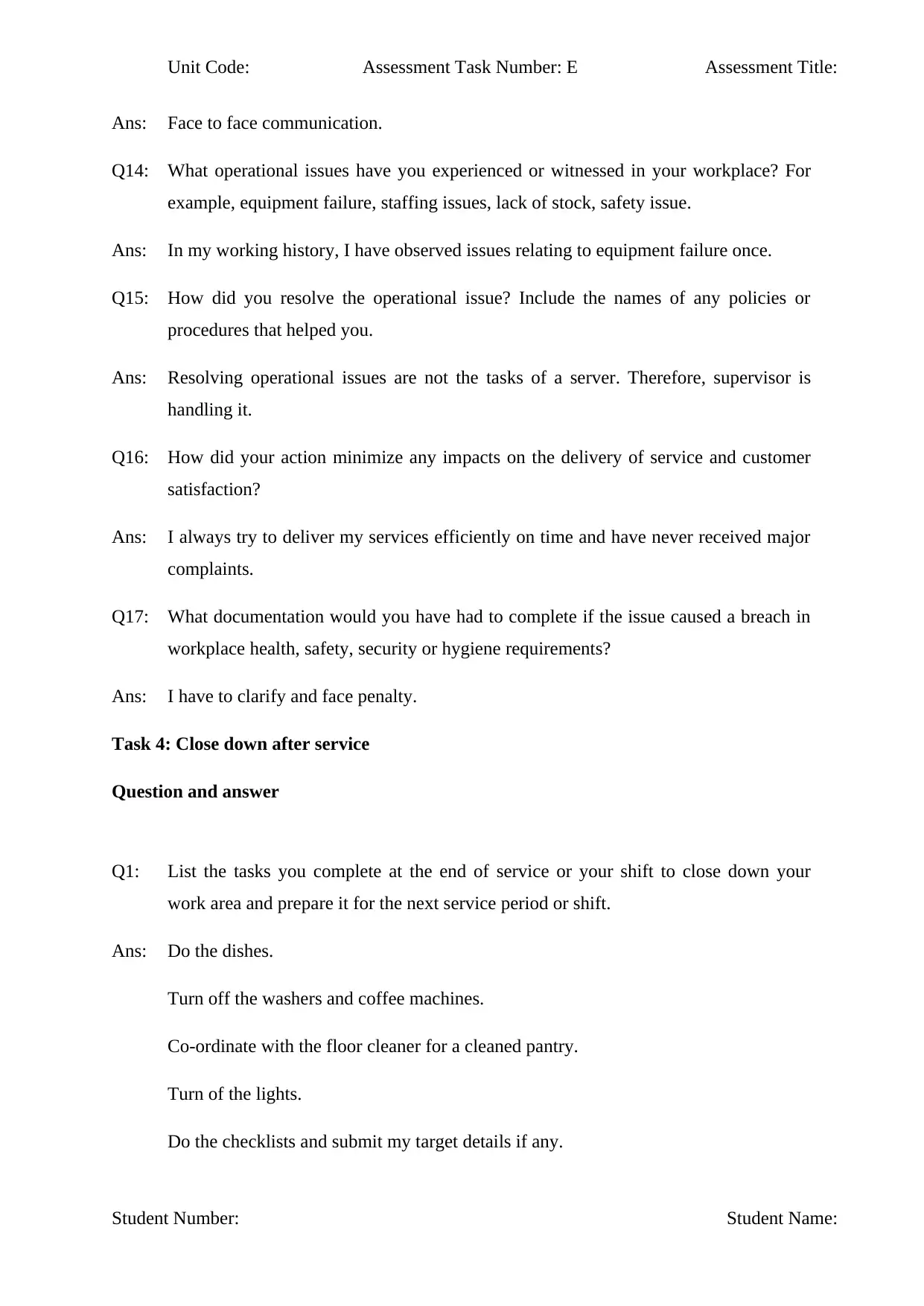
Unit Code: Assessment Task Number: E Assessment Title:
Ans: Face to face communication.
Q14: What operational issues have you experienced or witnessed in your workplace? For
example, equipment failure, staffing issues, lack of stock, safety issue.
Ans: In my working history, I have observed issues relating to equipment failure once.
Q15: How did you resolve the operational issue? Include the names of any policies or
procedures that helped you.
Ans: Resolving operational issues are not the tasks of a server. Therefore, supervisor is
handling it.
Q16: How did your action minimize any impacts on the delivery of service and customer
satisfaction?
Ans: I always try to deliver my services efficiently on time and have never received major
complaints.
Q17: What documentation would you have had to complete if the issue caused a breach in
workplace health, safety, security or hygiene requirements?
Ans: I have to clarify and face penalty.
Task 4: Close down after service
Question and answer
Q1: List the tasks you complete at the end of service or your shift to close down your
work area and prepare it for the next service period or shift.
Ans: Do the dishes.
Turn off the washers and coffee machines.
Co-ordinate with the floor cleaner for a cleaned pantry.
Turn of the lights.
Do the checklists and submit my target details if any.
Student Number: Student Name:
Ans: Face to face communication.
Q14: What operational issues have you experienced or witnessed in your workplace? For
example, equipment failure, staffing issues, lack of stock, safety issue.
Ans: In my working history, I have observed issues relating to equipment failure once.
Q15: How did you resolve the operational issue? Include the names of any policies or
procedures that helped you.
Ans: Resolving operational issues are not the tasks of a server. Therefore, supervisor is
handling it.
Q16: How did your action minimize any impacts on the delivery of service and customer
satisfaction?
Ans: I always try to deliver my services efficiently on time and have never received major
complaints.
Q17: What documentation would you have had to complete if the issue caused a breach in
workplace health, safety, security or hygiene requirements?
Ans: I have to clarify and face penalty.
Task 4: Close down after service
Question and answer
Q1: List the tasks you complete at the end of service or your shift to close down your
work area and prepare it for the next service period or shift.
Ans: Do the dishes.
Turn off the washers and coffee machines.
Co-ordinate with the floor cleaner for a cleaned pantry.
Turn of the lights.
Do the checklists and submit my target details if any.
Student Number: Student Name:
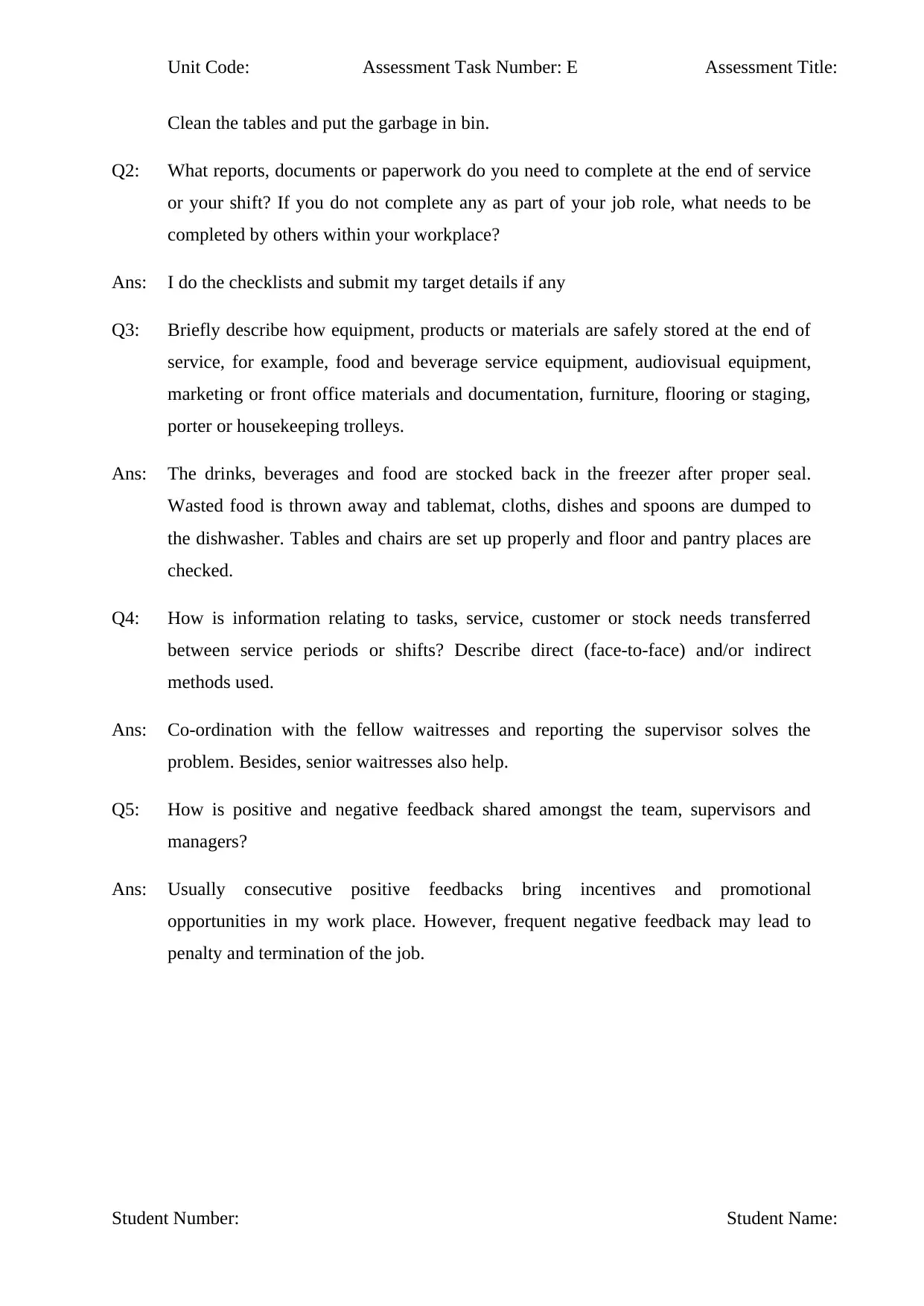
Unit Code: Assessment Task Number: E Assessment Title:
Clean the tables and put the garbage in bin.
Q2: What reports, documents or paperwork do you need to complete at the end of service
or your shift? If you do not complete any as part of your job role, what needs to be
completed by others within your workplace?
Ans: I do the checklists and submit my target details if any
Q3: Briefly describe how equipment, products or materials are safely stored at the end of
service, for example, food and beverage service equipment, audiovisual equipment,
marketing or front office materials and documentation, furniture, flooring or staging,
porter or housekeeping trolleys.
Ans: The drinks, beverages and food are stocked back in the freezer after proper seal.
Wasted food is thrown away and tablemat, cloths, dishes and spoons are dumped to
the dishwasher. Tables and chairs are set up properly and floor and pantry places are
checked.
Q4: How is information relating to tasks, service, customer or stock needs transferred
between service periods or shifts? Describe direct (face-to-face) and/or indirect
methods used.
Ans: Co-ordination with the fellow waitresses and reporting the supervisor solves the
problem. Besides, senior waitresses also help.
Q5: How is positive and negative feedback shared amongst the team, supervisors and
managers?
Ans: Usually consecutive positive feedbacks bring incentives and promotional
opportunities in my work place. However, frequent negative feedback may lead to
penalty and termination of the job.
Student Number: Student Name:
Clean the tables and put the garbage in bin.
Q2: What reports, documents or paperwork do you need to complete at the end of service
or your shift? If you do not complete any as part of your job role, what needs to be
completed by others within your workplace?
Ans: I do the checklists and submit my target details if any
Q3: Briefly describe how equipment, products or materials are safely stored at the end of
service, for example, food and beverage service equipment, audiovisual equipment,
marketing or front office materials and documentation, furniture, flooring or staging,
porter or housekeeping trolleys.
Ans: The drinks, beverages and food are stocked back in the freezer after proper seal.
Wasted food is thrown away and tablemat, cloths, dishes and spoons are dumped to
the dishwasher. Tables and chairs are set up properly and floor and pantry places are
checked.
Q4: How is information relating to tasks, service, customer or stock needs transferred
between service periods or shifts? Describe direct (face-to-face) and/or indirect
methods used.
Ans: Co-ordination with the fellow waitresses and reporting the supervisor solves the
problem. Besides, senior waitresses also help.
Q5: How is positive and negative feedback shared amongst the team, supervisors and
managers?
Ans: Usually consecutive positive feedbacks bring incentives and promotional
opportunities in my work place. However, frequent negative feedback may lead to
penalty and termination of the job.
Student Number: Student Name:
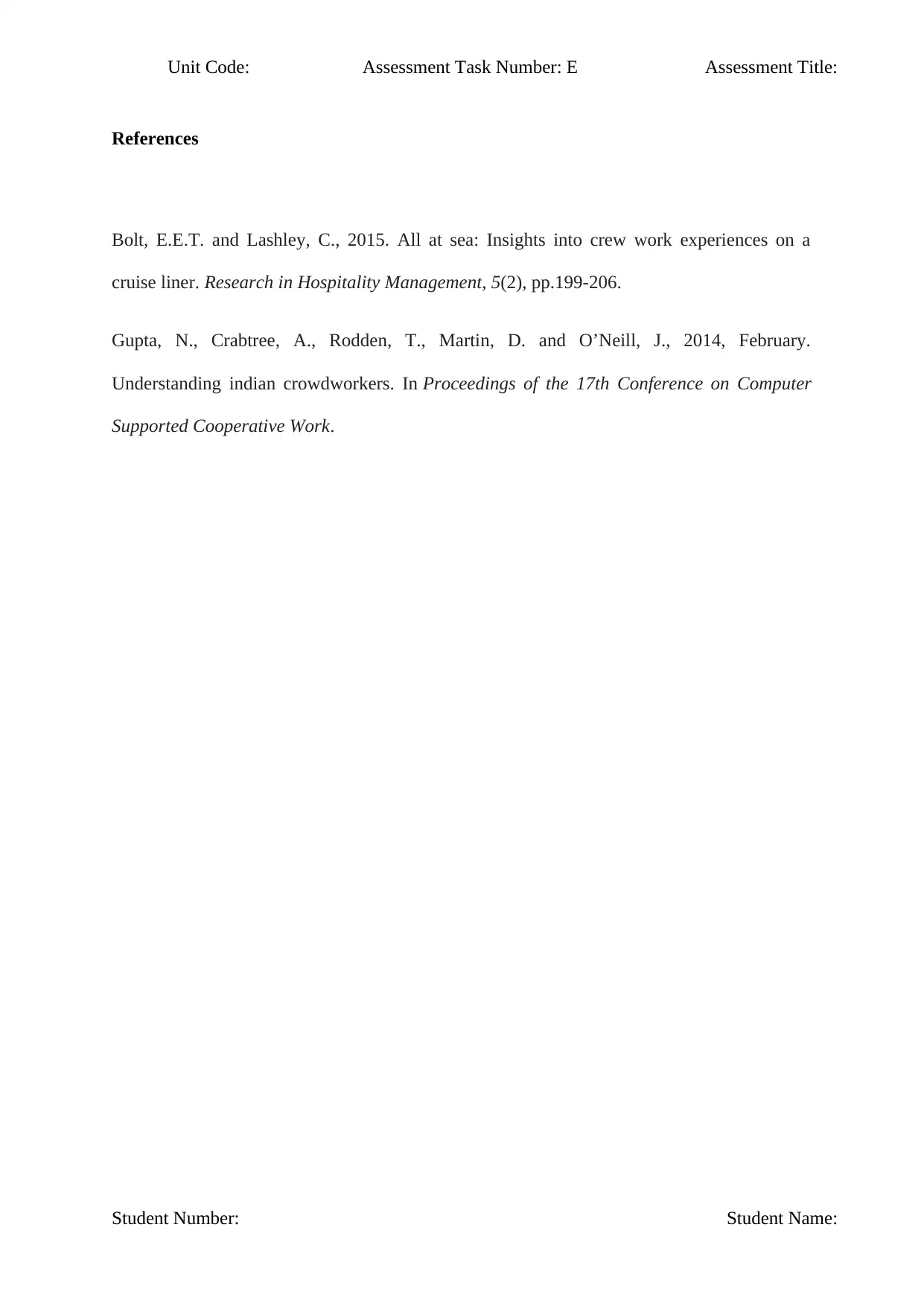
Unit Code: Assessment Task Number: E Assessment Title:
References
Bolt, E.E.T. and Lashley, C., 2015. All at sea: Insights into crew work experiences on a
cruise liner. Research in Hospitality Management, 5(2), pp.199-206.
Gupta, N., Crabtree, A., Rodden, T., Martin, D. and O’Neill, J., 2014, February.
Understanding indian crowdworkers. In Proceedings of the 17th Conference on Computer
Supported Cooperative Work.
Student Number: Student Name:
References
Bolt, E.E.T. and Lashley, C., 2015. All at sea: Insights into crew work experiences on a
cruise liner. Research in Hospitality Management, 5(2), pp.199-206.
Gupta, N., Crabtree, A., Rodden, T., Martin, D. and O’Neill, J., 2014, February.
Understanding indian crowdworkers. In Proceedings of the 17th Conference on Computer
Supported Cooperative Work.
Student Number: Student Name:
1 out of 10
Related Documents
Your All-in-One AI-Powered Toolkit for Academic Success.
+13062052269
info@desklib.com
Available 24*7 on WhatsApp / Email
![[object Object]](/_next/static/media/star-bottom.7253800d.svg)
Unlock your academic potential
© 2024 | Zucol Services PVT LTD | All rights reserved.




